
SANITATION...... which is to say, drains, toilets, sewage, and clean water. | ||
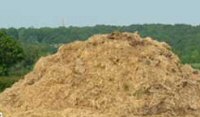
|
One of the the pair of biggest problems of any group of people living anywhere, at any time in history, is, "Where do we get the drinking water?" and the other is, "What do we do with all the sewage?" There have been lots of different answers to both questions. By the way, I'm being kind to you. That's just a pile of horse dung... |
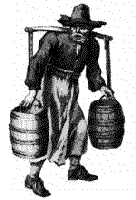 |
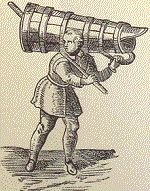 |
Getting the waterOne answer involves spending a lot of time simply carrying it.This is still the case in many parts of the world nowadays. OXFAM recently helped a village in Africa where the children never went to school because they were spending so long on the five hour walk to get water. That's five HOURS each way. Medieval women spent long hours doing exactly the same, though in England and Europe they didn't generally have to walk anything like so far each time. The pictures here show some water-carrying men of the 15- and 1600's And a modern day African girl. |
 |
Getting rid of the sewageIt's good to be sure that what you're drinking isn't infected by what somebody else got rid of earlier.This might be simply further up the same stream or river, or, as in Victorian London, it might be a nasty case of getting your own back. For years what was called the "night soil" was all carted away to spread on the fields. |
||
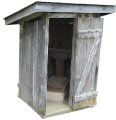 
|
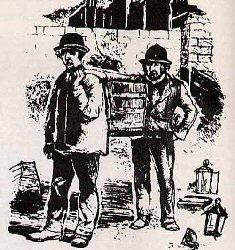 Two nightsoil men carrying the stuff away. Where there was room, they'd use a horse & cart. |
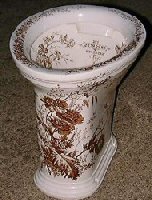

|
 Return to top of this page. Return to top of this page.Then it became fashionable to have the early flush toilets instead. What ought to have been an improvement turned into a problem, since the resulting watery waste, complete with bacteria & germs, leaked its way into the water supply system. There it spread cholera and other diseases. One of the people who helped solve this problem was Sir Joseph Bazalgette. Rather than put more stuff here, I can't do better than to point you at  http://www.crossness.org.uk/ http://www.crossness.org.uk/
It's mainly about a Victorian pumping station designed by Sir Joseph Bazalgette, but look at the HISTORY and it leads to much useful information. Go & see! - but when you've finished, just close the window which will open up (click on the x in the top right of that window) and you'll return to this page. Haste Ye Back!! Here's another link, to a site all about John Snow, the man who researched cholera and its causes in Victorian London. This site is aimed at quite serious students, and takes a bit of getting through, but there is lots of information, both by modern researchers and by John Snow himself. If you have the right software, there's sound and other material on this site. I haven't checked those parts. - but I have read quite a bit of the page I'm pointing you at, and some of it will really turn your stomach!  "http://www.ph.ucla.edu/epi/snow/broadstreetpump.html" "http://www.ph.ucla.edu/epi/snow/broadstreetpump.html"Now a growing number of people are saying that rather than spend lots of money on complicated ways of cleaning all the water we use to flush the sewage away we need to work more on good ways of recycling it, either in sawdust toilets or other ways of getting it to turn into compost, so we can grow enough food to keep us all fed on this planet. Bring back the nightsoilmen? | ||
 Return to top of this page.
Copyright ©: 2009, Richard York
Return to top of this page.
Copyright ©: 2009, Richard York